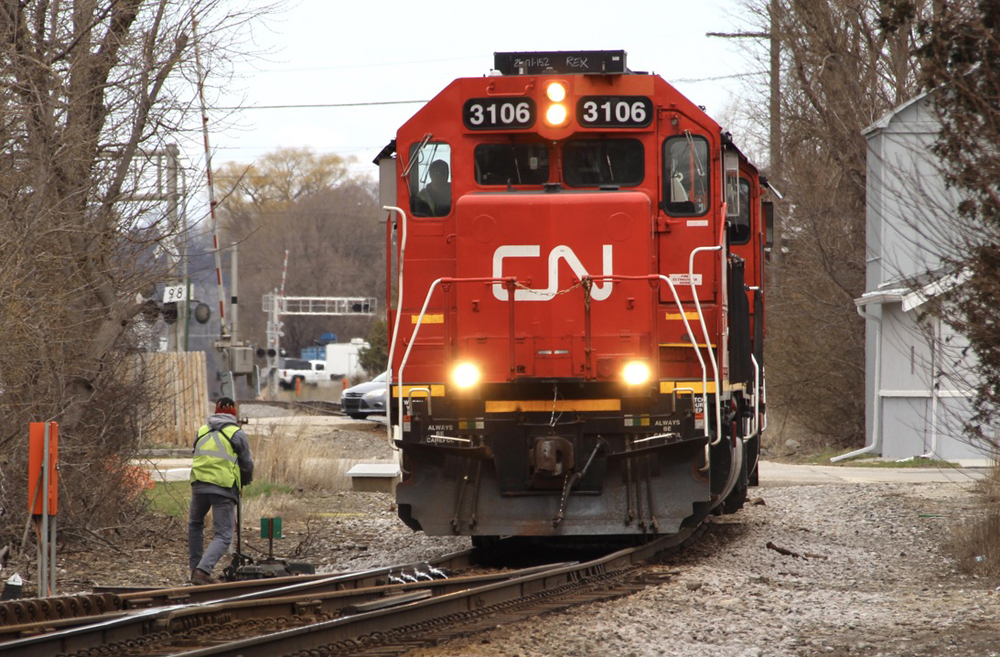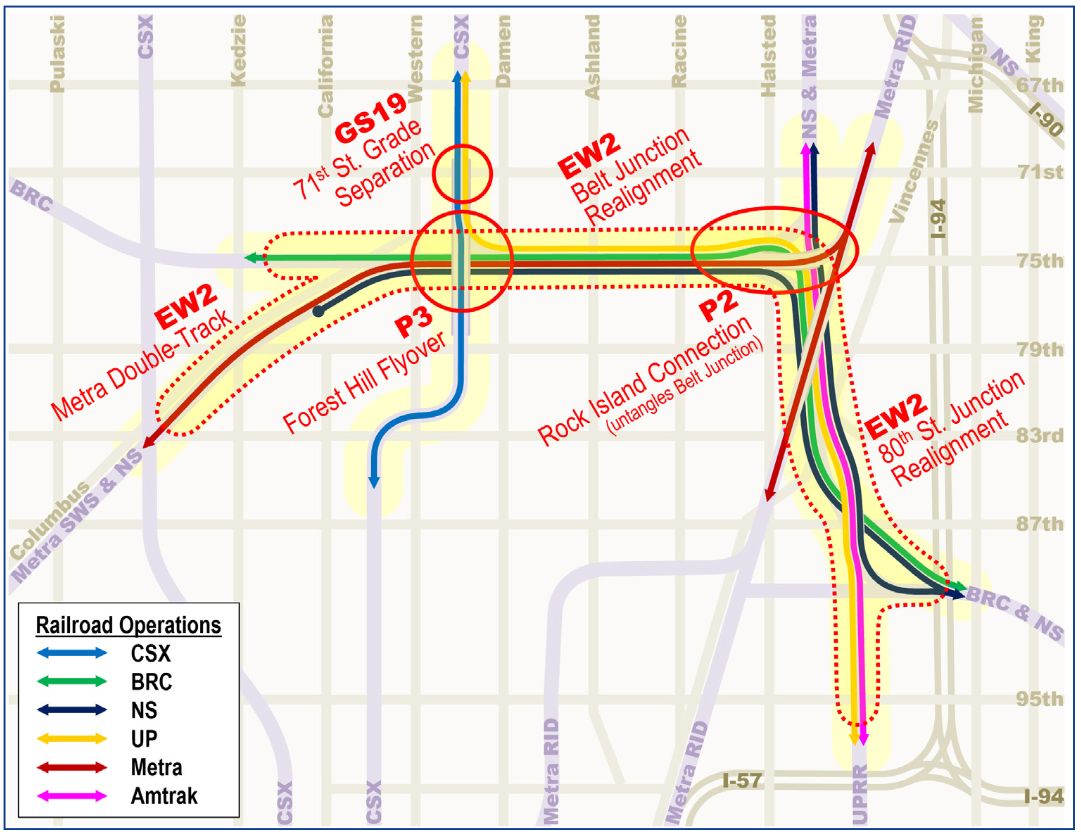CHICAGO — Newly released video taken from the cab of a Metra commuter train shows the train narrowly missing a vehicle as it passed through a crossing where the gates had not lowered.
It was the second video of a harrowing close call that took place Nov. 9 on the Metra Rock Island Line tracks at 191st Street in Mokena, Ill.
A dramatic dashcam video from a Mokena police car also captured the incident and was widely viewed last month.
Both videos appear to show the same vehicle, a dark SUV, passing through the crossing just a moment before the train.
The new video, taken from a camera in the cab car where the engineer operates the train, was released by Metra in response to a Freedom of Information Act request.
The squad car video shows the vehicle, a dark SUV, just about to enter the crossing as the fast-moving train also arrives. The driver, Police Officer Peter Stanglewicz, was able to swerve hard left and drove across the raised median as the train passes.
According to Metra, the incident occurred around 8:45 a.m. as Metra train 506 was inbound head to LaSalle Street Station.
Stanglewicz’s squad was just a few car lengths behind the SUV, which made it safely through the crossing. Another car could be seen approaching from the opposite direction, but stopped in time.
Metra said a signal maintainer happened to be at the site at the time on a separate issue, and the crossing was shut down to trains until the malfunction was investigated and repaired by 3:40 p.m. that day.
The malfunction was traced to an electrical short in a hand throw switch, which controlled a nearby siding used by a lumber yard.
Metra said it “aggressively tested” the crossing and reported the incident to the Federal Railroad Administration. As a backup, crews were instructed to take additional precautions there using visual signals.
The incident first came to light after Stanglewicz posted the video on his personal Facebook page Dec. 21. The video has attracted more than a million views.
Stanglewicz posted: “Throughout my life, I’ve had very little luck. I’ve bought tons of raffle tickets, from little league tickets to charity raffles. Every lottery ticket was a loser. I just thought I wasn’t born with luck at all. Little did I know, I had luck, I was just saving it all up for the perfect time. Here is all my luck being used ALL AT ONCE. If I never win anything again, I’m perfectly fine with that.”














Mr. Antoniazzi: Do you remember the wig wag signals @ grade crossings in the 50s? Despite the fact they weren’t high tech they got a driver’s undivided attention well in advance of an oncoming train.
Century 21 man has come to rely much to much on all the expensive electronic crap that is stuffed into everything, from automatic diaper changers so mom doesn’t have to get up in the middle of the night to change Baby Herman, to vehicles that catch on fire while standing still (always called just another minor technical defect) to model trains that contain $100.00 worth of useless unrealistic expensive sound systems* to the point model railroading is fast becoming a rich man’s hobby.
* There are exceptions. Be sure and check out Piko’s large scale steam locomotives with sound on YouTube. The sound is oh so sweet and what’s really cool is the fact the locomotives come “equipped” with an affordable Nice Price!
Since electricity was my favorite subject to teach in physics ……well……way to go Anna. Most excellent, as are always, your comments. endmrw0117191024
It is difficult to take media reports at face value in regards to technical issues. Any kind of electrical defect, for example, they will call a “short”, even if it was nothing of the kind. This might be done through ignorance on the part of the copywriter, although I suspect it is a pandering to the lowest common denominator in their readership.
But let us take this reportage at face value, and that the switch in question did actually short across – got wet, whatever – and this was taken as a signal to hold off the crossing gates. This would mean that the switch is normally open and closes on operation.
Any electrical engineer can tell you that to set something like that up, in a harsh environment, is just asking for trouble. There is no line supervision, you won’t know if the line has been cut or tampered with, you won’t know if the switch is still there even. This is simply not acceptable in a safety system.
The same engineer (if he has experience with fail-safe systems and sensors) will tell you that what you do is to use a DPDT switch and extend to the common on the switch a DC voltage – needn’t be high, needn’t have much current behind it, this is a signal not a power line. Then, you wire the switch so that if it is in one position you get back one polarity, but if the switch is operated you get back the opposite polarity. It is a four-wire circuit. If the return signal drops out altogether you know the line is open. If you float it a known value above ground and monitor with respect to ground, you can tell if it somehow has shorted to ground.
In any of these cases (except proper operation) the crossing gates should fail-safe. In this case they didn’t.
If there had been an accident, do you have any idea what I could do with a jury and this explanation? I could retire, probably to the Bahamas.
Metra, you need to look hard at your equipment vendor and what they are selling you. Before someone gets killed.
The above comments are general in nature and do not form the basis for an attorney/client relationship. They do not constitute legal advice. I am not your attorney. Find your own damn lawyer.
In the police dashcam video, there is a car coming the opposite direction to the police car that looks like it is actually closer to getting hit than the car directly in front of the police car. Where is this car in teh cab footage? You don’t even see it.
I witnessed something like this on the BNSF in Hinsdale IL during a morning rush some years ago. I was lining up a shot of an oncoming commuter when a car flashed thru the bottom of the scene (the gates were not visible in my framing) and I thought, “Hold on, shouldn’t the gates be down by now?” The crossing was dead, no bells, lights or gates. As the train closed in I ran out in the street and frantically waved my arms to stop traffic, luckily no one tried to run me down. About 15 seconds after the train passed, the gates finally activated and went down, but I still called the BNSF emergency number. The response was impressive; the next commuter stopped at the crossing and dropped half its crew to flag crossings thru town. The fire department showed up, the police showed up and that’s when I began to get worried that maybe I witnessed some kind of momentary glitch and I’d get accused of doing something wrong. The signal department showed up surprisingly fast, they just happened to be traveling thru the area when I called. They were very happy to see me and thanked me for my help. A couple months later I ran into them again and the foreman came over to tell me that after a lot of testing they did find the glitch, which was a relief!
Strange, the video, actually both videos worked just fine for me.
And I’m in agreement with Mr. Toth. I look at situations like this, compare them with crossing gate technology as developed back in the 50’s and I just smell over-engineering.
Keep it simple people. You’ll be better off in the long run.
Screen went black on me too.
Hmmm! I can’t get the Metra cab video to work. When I click on it the screen turns black and nothing happens. Am I the only one?
Matt and Edward,
That’s what happens with perspective, which is what you see looking through the police cars dash cam, that car that APPEARS to be closer than the SUV is actually FURTHER away than you think.
The CSX crossing in Tampa Florida @ S. Himes Ave. was plagged with constant problems back in the 90s. No train in sight on the Port Tampa line but the lights would start to flash, bells ring, and the gates lowered. Despite regular check ups performed by signal maintainers they would start to mal function over and over again and over again!
Perhaps it’s time to quit relying on all the high tech wonders of Century 21 and just resort to old fashioned human brain power instead and Stop, Look & Listen before one crosses railroad tracks? Remember, the life you save might be your own.
So what’s the problem here? Everything I know about crossing gates says they’re supposed to drop automatically in case of any kind of system failure. Is that not true anymore?
Matt, I wondered the same thing.